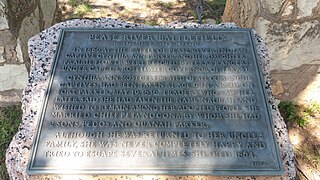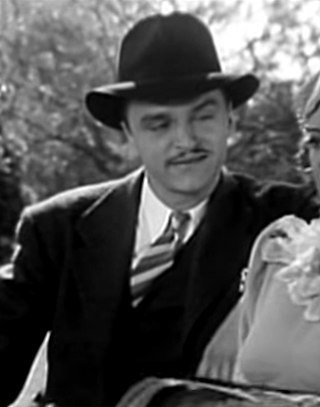
James MaitlandStewart was an American actor. Known for his distinctive drawl and everyman screen persona, Stewart's film career spanned 80 films from 1935 to 1991. With the strong morality, which he portrayed both on and off the screen, he epitomized the "American ideal" in the mid-twentieth century. In 1999, the American Film Institute (AFI) ranked him third on its list of the greatest American male actors. He received numerous honors including the AFI Life Achievement Award in 1980, the Kennedy Center Honor in 1983, as well as the Academy Honorary Award and Presidential Medal of Freedom, both in 1985.

John Martin Feeney, known professionally as John Ford, was an American film director and producer. He is regarded as one of the most important and influential filmmakers during the Golden Age of Hollywood, and was one of the first American directors to be recognized as an auteur. In a career of more than 50 years, he directed over 140 films between 1917 and 1965, and received six Academy Awards including a record four wins for Best Director for The Informer (1935), The Grapes of Wrath (1940), How Green Was My Valley (1941), and The Quiet Man (1952).

The Fort Parker massacre, also known as the Fort Parker raid, was an event in which a group of Texian colonists were killed in an attack by a contingent of Comanche, Kiowa, Caddo, and Wichita raiders at Fort Parker on May 19, 1836. During the attack, Cynthia Ann Parker, then approximately nine years old, was captured and spent most of the rest of her life within the Comanche Nation, later marrying Chief Peta Nocona and giving birth to a son, Quanah Parker, who became a prominent leader of the Comanches and a war leader during the Red River War of 1874–75. Cynthia’s brother John Richard Parker was also captured and remained with the Comanches for six years before his release was negotiated. He was unable to readapt to Western society and chose to return to the Comanche Nation.

Quanah Parker was a war leader of the Kwahadi ("Antelope") band of the Comanche Nation. He was likely born into the Nokoni ("Wanderers") band of Tabby-nocca and grew up among the Kwahadis, the son of Kwahadi Comanche chief Peta Nocona and Cynthia Ann Parker, an Anglo-American who had been abducted as an eight-year-old child and assimilated into the Nokoni tribe. Following the apprehension of several Kiowa chiefs in 1871, Quanah Parker emerged as a dominant figure in the Red River War, clashing repeatedly with Colonel Ranald S. Mackenzie. With European-Americans hunting American bison, the Comanches' primary sustenance, into near extinction, Quanah Parker eventually surrendered and peaceably led the Kwahadi to the reservation at Fort Sill, Oklahoma.

Cynthia Ann Parker, Naduah, Narua, or Preloch, was a woman who was captured by a Comanche band during the Fort Parker massacre in 1836, where several of her relatives were killed. She was taken with several of her family members, including her younger brother John Richard Parker. Parker was later adopted into the tribe and had three children with a chief. Twenty-four years later she was relocated and taken captive by Texas Rangers, at approximately age 33, and unwillingly forced to separate from her sons and conform to European-American society. Her Comanche name means "was found" or "someone found" in English.

Peta Nocona, also known as Puhtocnocony, or Tah-con-ne-ah-pe-ah, the son of Puhihwikwasu'u, or Iron Jacket, was a chief of the Comanche Quahadi band. He married Cynthia Ann Parker, who had been taken as a captive in a raid and was adopted into the tribe by Tabby-nocca's family. Among their children was Quanah Parker, the last war chief of the Comanche.

The Comanche Wars were a series of armed conflicts fought between Comanche peoples and Spanish, Mexican, and American militaries and civilians in the United States and Mexico from as early as 1706 until at least the mid-1870s. The Comanche were the Native American inhabitants of a large area known as Comancheria, which stretched across much of the southern Great Plains from Colorado and Kansas in the north through Oklahoma, Texas, and eastern New Mexico and into the Mexican state of Chihuahua in the south. For more than 150 years, the Comanche were the dominant native tribe in the region, known as “the Lords of the Southern Plains”, though they also shared parts of Comancheria with the Wichita, Kiowa, and Kiowa Apache and, after 1840, the southern Cheyenne and Arapaho.

The Alamo is a 1960 American epic historical war film about the 1836 Battle of the Alamo produced and directed by John Wayne and starring Wayne as Davy Crockett. The film also co-stars Richard Widmark as Jim Bowie and Laurence Harvey as William B. Travis, and features Frankie Avalon, Patrick Wayne, Linda Cristal, Joan O'Brien, Chill Wills, Joseph Calleia, Ken Curtis, Ruben Padilla as Santa Anna, and Richard Boone as Sam Houston. Shot in 70 mm Todd-AO by William H. Clothier, it was released by United Artists.

Henry Hathaway was an American film director and producer. He is best known as a director of Westerns, especially starring Randolph Scott and John Wayne. He directed Gary Cooper in seven films.

Henry Brandon was an American film and stage character actor with a career spanning almost 60 years, involving more than 100 films; he specialized in playing a wide diversity of ethnic roles.

Ford Rainey was an American film, stage, and television actor.
Herman Lehmann was captured as a child by Native Americans. He lived first among the Apache and then the Comanche but returned to his Euro-American birth family later in life. He published his autobiography, Nine Years Among the Indians, in 1927.

The Fighting Kentuckian is a 1949 American Adventure Western film written and directed by George Waggner and starring John Wayne, who also produced the film. The supporting cast featured Vera Ralston; Philip Dorn; Oliver Hardy portraying Wayne's portly sidekick; Marie Windsor; John Howard; Hugo Haas; Grant Withers and Odette Myrtil.

The Council House Fight, often referred to as the Council House Massacre, was a fight between soldiers and officials of the Republic of Texas and a delegation of Comanche chiefs during a peace conference in San Antonio on March 19, 1840. About 35 Comanche men and women under chief, Mukwooru represented just fraction of the Penateka band of the southern portion of the Comanche tribe. He knew he had no authority to speak for the Southern tribes as a whole and thus, any discussions of peace would be simply a farce. However, if Mukwooru could re-establish a lucrative trade with the San Antonian's perhaps a peace, by proxy, could be established. Just as the Comanche had done had been done for centuries in San Antonio, Santa Fe and along the Rio Grande. They would rob one settlement and sell to the other.

The Battle of Pease River, also known as the Pease River Massacre or the Pease River fight, occurred on December 19, 1860, near the present-day town of Margaret, Texas in Foard County, Texas, United States. The town is located between Crowell and Vernon within sight of the Medicine Mounds just outside present-day Quanah, Texas.
The Texas–Indian wars were a series of conflicts between settlers in Texas and the Southern Plains Indians during the 19th-century. Conflict between the Plains Indians and the Spanish began before other European and Anglo-American settlers were encouraged—first by Spain and then by the newly Independent Mexican government—to colonize Texas in order to provide a protective-settlement buffer in Texas between the Plains Indians and the rest of Mexico. As a consequence, conflict between Anglo-American settlers and Plains Indians occurred during the Texas colonial period as part of Mexico. The conflicts continued after Texas secured its independence from Mexico in 1836 and did not end until 30 years after Texas became a state of the United States, when in 1875 the last free band of Plains Indians, the Comanches led by Quahadi warrior Quanah Parker, surrendered and moved to the Fort Sill reservation in Oklahoma.

John Ford (1894–1973) was an American film director whose career spanned from 1913 to 1971. During this time he directed more than 140 films; however, nearly all of his silent films are lost. Born in Maine, Ford entered the filmmaking industry shortly after graduating from high school with the help of his older brother, Francis Ford, who had established himself as a leading man and director for Universal Studios. After working as an actor, assistant director, stuntman, and prop man – often for his brother – Universal gave Ford the opportunity to direct in 1917. Initially working in short films, he quickly moved into features, largely with Harry Carey as his star.
William Everett Cook, was a western writer who used the pen names Will Cook,James Keene,Wade Everett and Frank Peace. Called "a master western storyteller," Cook published dozens of short stories and 50 novels before his death at age 42. A number of his stories and novels were turned into Hollywood westerns, including the 1961 John Ford film Two Rode Together.
Carne Muerto (Tehcap) was a War Chief of the Quahadi band of the Comanche Indians.

They Rode West is a 1954 American Western film directed by Phil Karlson. It reunites the stars of The Caine Mutiny, Robert Francis and May Wynn. It also stars Donna Reed and Philip Carey. Based on the story Wood Hawk by Leo Katcher, it was filmed at the Corriganville movie ranch, using the same fort set that was built in 1948 for the John Ford film "Fort Apache."















